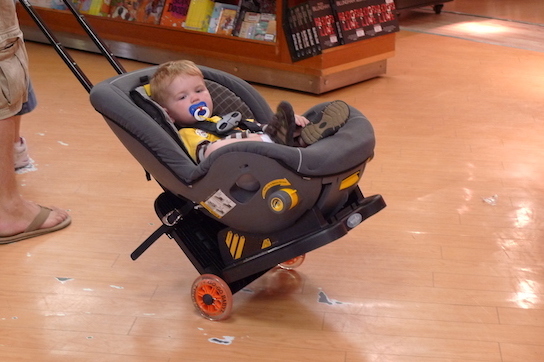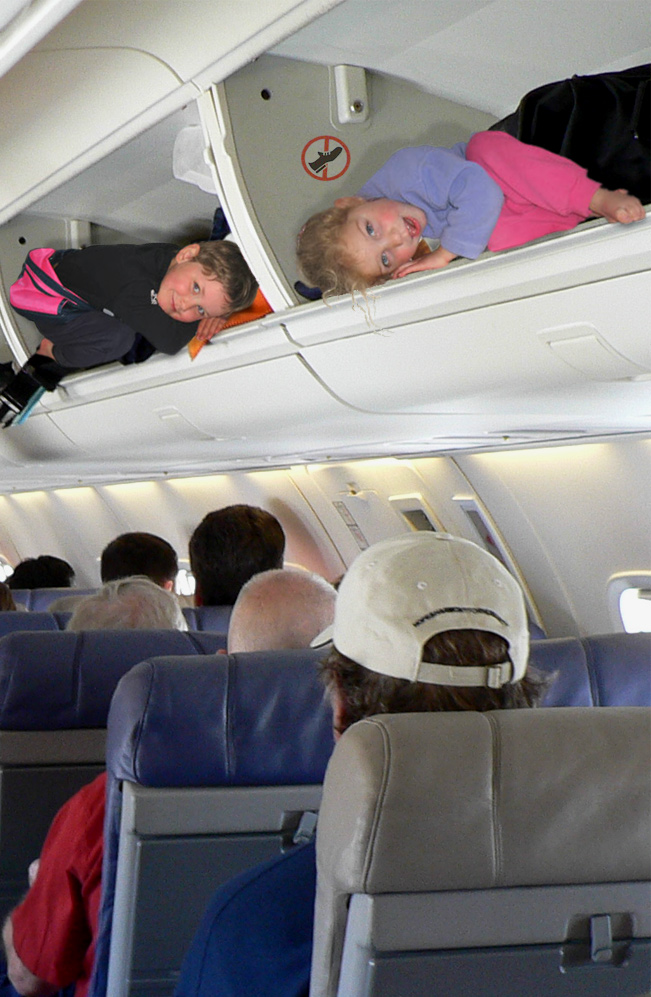You're all set for your family summer vacation -- flights are booked, bags are packed, and games are overflowing in carry-ons to keep the kids entertained. While figuring out a way to keep the little ones quiet on board was easy peasy, ensuring their safety might be a bit more complicated. That's why we tapped Allana Pinkerton, Certified Child Passenger Safety Technician and Global Safety Advocate for Diono. "Traveling with children takes skill, patience, organization, and lots of love," she says.
Photo courtesy of Flickr/Eric Lefevre-Ardant
Many experts would agree that air travel is the safest mode of transportation. Yet, while crashes of major commercial carriers are rare, turbulence and rough take-offs and landings are not. Severely bumpy flights can cause injuries to passengers, even sending some to the hospital. According to Pinkerton, a child’s car seat can help prevent them from getting hurt during these rough episodes. “Most people only think about using a car seat for children when traveling in a car, but the reality is they are just as important when flying,” she says.
Installing a car seat has other benefits as well. “The car seat will be intact when you arrive at your destination instead of tossed around by baggage handlers,” says Pinkerton. “You’ll also be familiar with how to install the car seat in the rental vehicle and most importantly, your child will be in familiar surroundings, which could relieve the stress of traveling.” That being said, your kid’s safety certainly extends beyond solely bringing a proper car seat. Here, Pinkerton shares 11 tips for making flying with children easier and safer.
Photo courtesy of Flickr/Ma1974
1. No one wants to be the parents with the screaming kid on the plane, so try and book flights in conjunction with your baby’s nap time. If your little one is used to sleeping at a certain time, they’re more likely to be fast asleep during a flight, too.
2. Similar to adults, some babies can feel discomfort in their ears when the cabin pressure changes (it may be one of the reasons they’re crying). Pacifiers or feeding time might help alleviate these symptoms.
3. Look for a foldable car seat and carry bag to help protect the contraption. You’ll want a seat with a low-profile design, so that children can easily use the fold-down tray for eating, playing games, or propping up their iPad during the flight.
4. If you have a car seat, travel with only the carrier, but be sure it can be installed without the base in a vehicle before leaving home. And don’t forget to bring the instruction manual, so you have it when you arrive at your destination.
5. Belt-positioning booster seats are not permitted on airplanes. Check your booster seat at the gate so it’s available when you land. Only seats with an internal harness are permitted as long as they have an FAA (Federal Aviation Administration) label.
6. The seat must be installed by a window so that it doesn’t interfere with passengers exiting the row. Note: You cannot install a seat in an emergency exit row.
7. Check with the airline for discount tickets for children under two years old. You might be able to save a few bucks, even if they aren’t lap tickets.
8. Some airlines allow early boarding for families with children, while others permit family boarding following their Platinum members. Pinkerton recommends boarding last if you have reserved seating. If you board first, you may feel rushed with people waiting behind you. It takes time to fold up the stroller at the gate, install the seat, and get your baby settled. The only disadvantage is that there might not be any space left in the overhead bins.
9. Be sure to bring plenty of snacks and toys to occupy your child throughout the process. As a reminder, any and all liquids are limited to four-ounce containers, per FAA regulations.
10. While some airports have family lines, others don’t, even if you have TSA PreCheck. Be prepared to remove shoes, coats, jewelry, laptops, and cameras with your kid in tow.
11. If it’s your first time flying with kids, call the airport and ask if you can practice a dry run. This will help your child become familiar with the process and reduce stress on travel day.
Related Stories:
- 7 Things You Need to Know Before Signing Up for TSA PreCheck
- 7 Facts That Could Save Your Life in a Plane Crash
- How to Fly with Your Pet and Not Have It Be the Worst Experience of Your Life
- 5 Travel Cribs for Families With Infants
All products are independently selected by our writers and editors. If you buy something through our links, Oyster may earn an affiliate commission.



